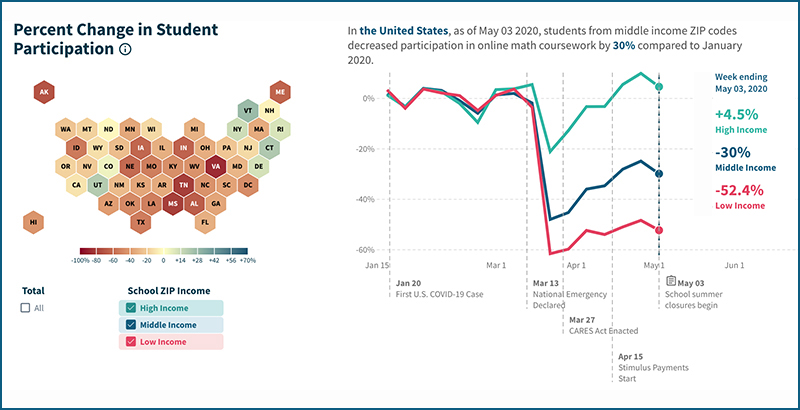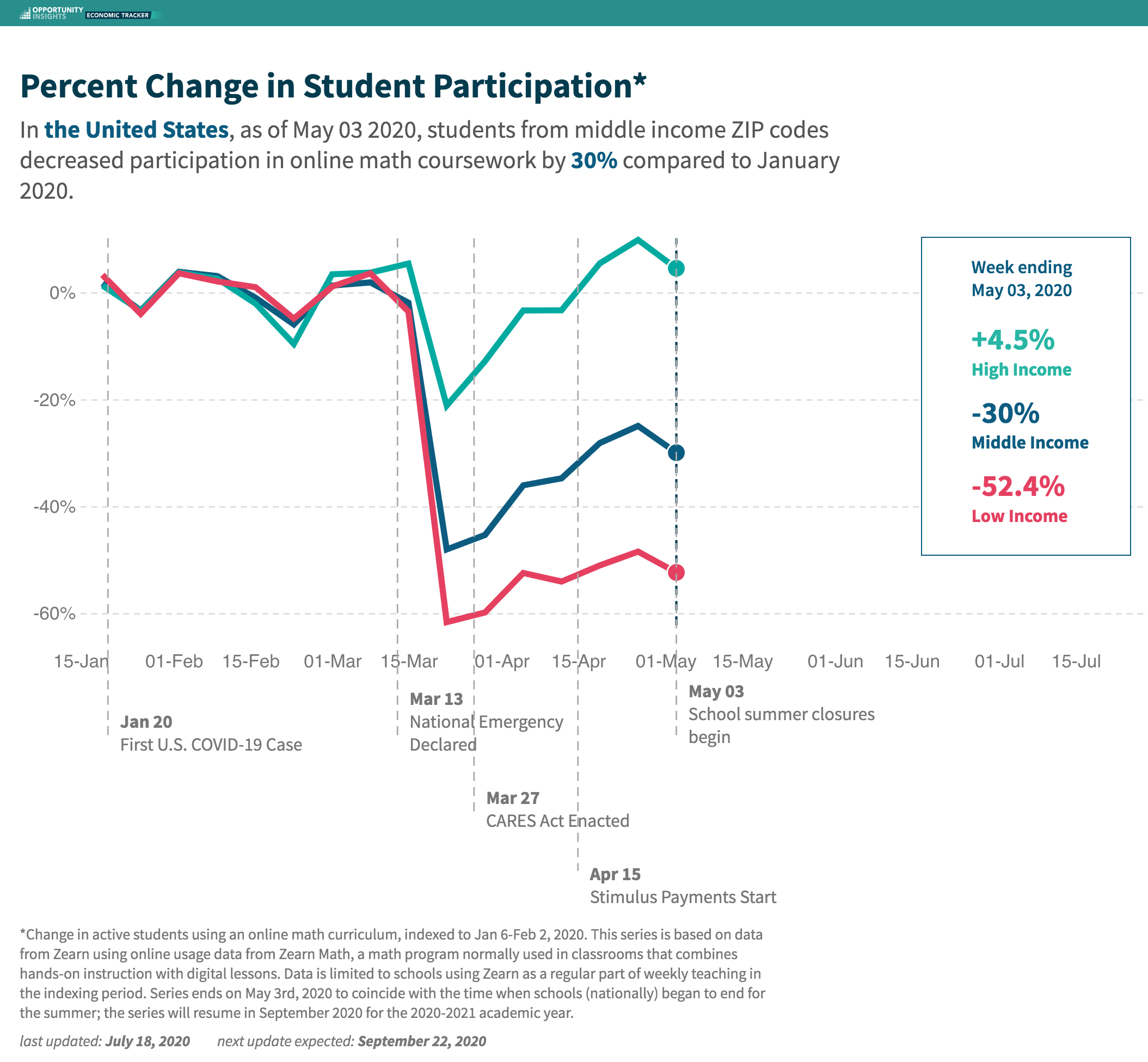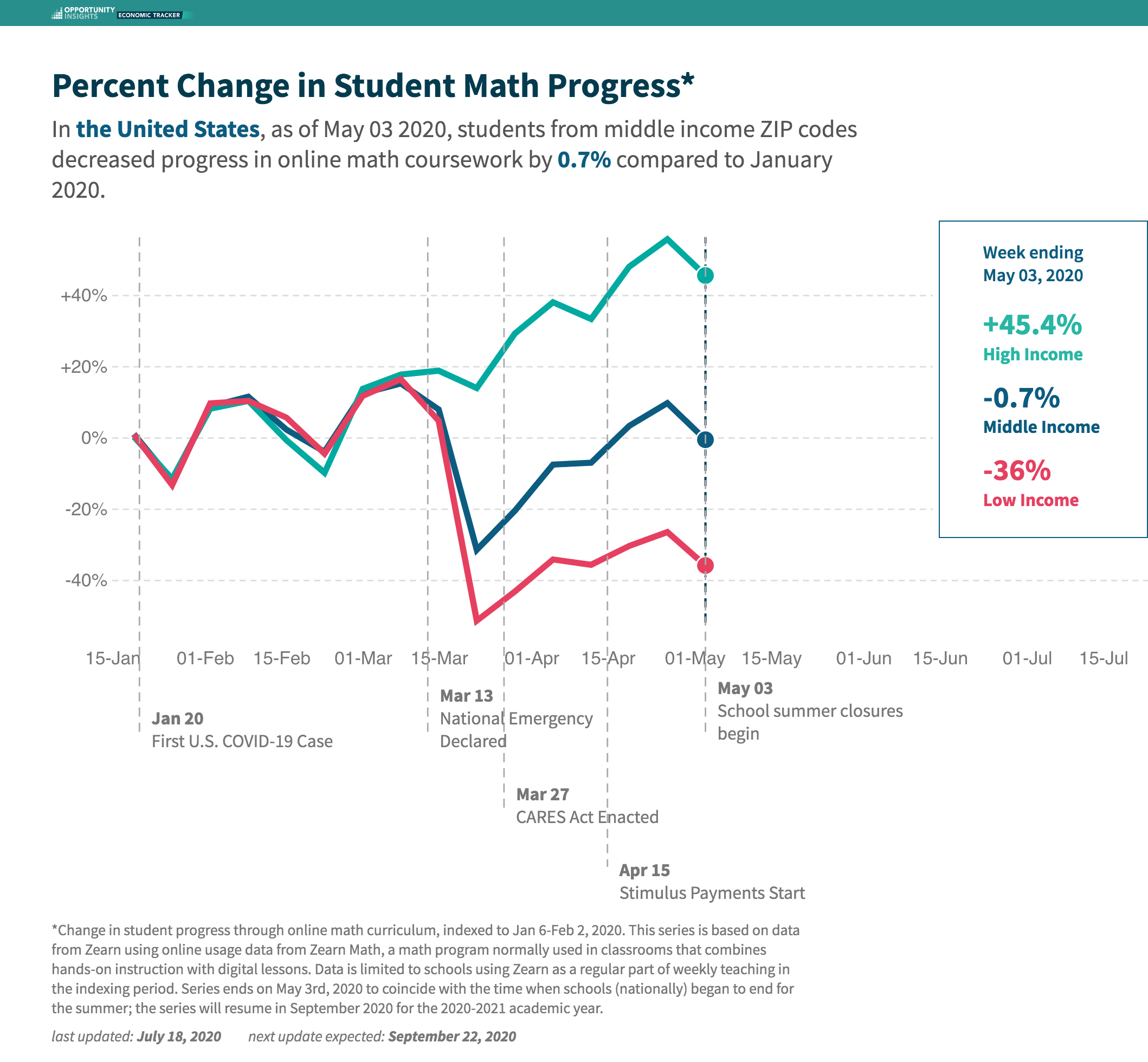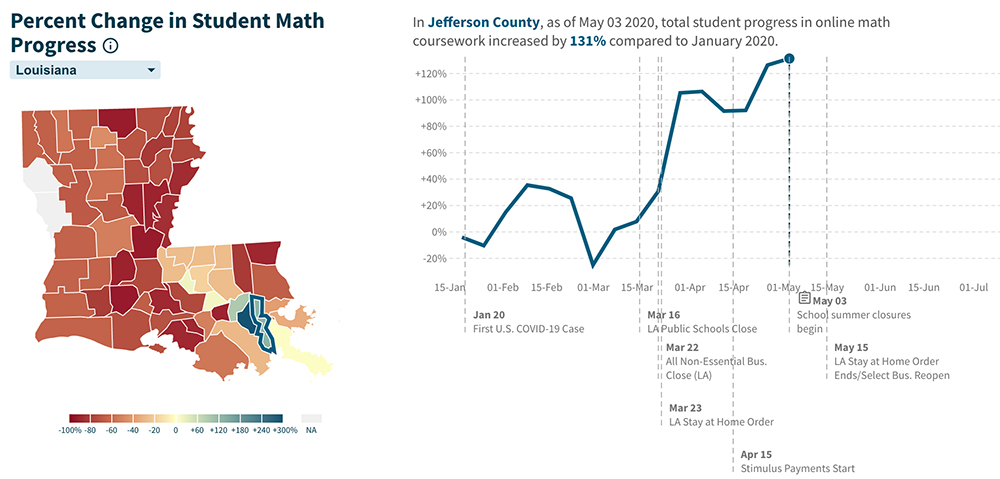New Data Suggest Pandemic May Not Just Be Leaving Low-Income Students Behind; It May Be Propelling Wealthier Ones Even Further Ahead

The pandemic may be exacerbating achievement gaps not only by leaving some students behind but also by propelling more privileged children even farther ahead academically, new data suggest.
Participation and mastery rates in Zearn Math, an online math program for students in kindergarten through fifth grade, offer a glimpse into the crisis: When schools shut down in mid-March, participation and progress dropped off for students from low- and middle-income communities but rose to levels higher than before the shutdown for those from high-income areas. Still, the numbers also show some communities overcame the barriers, keeping engagement strong for all students regardless of income.

The data track participation and progress through online lessons from Zearn, a nonprofit that offers free online math lessons and curriculum, which more than 2.5 million students in more than half the country’s school districts were using in class before school buildings closed in March. Researchers used a representative national sample of about 800,000 students from district public, charter and parochial schools.
The anonymous student data are publicly available as part of a new tracker from Opportunity Insights, a nonpartisan research group based at Harvard University’s economics department that is focused on studying economic inequality and improving upward mobility for American children.
The tracker uses Census Bureau data to categorize schools as low-, middle- or high-income according to the median household income of the zip code where they’re located.
Zearn co-founder and CEO Shalinee Sharma said she “flipped out” when she saw student use diverging by income. That would suggest a critical step backward in Zearn’s results, which, Sharma said, over the past four years showed that participation and progress have typically been about the same for students across income levels, countering the usual correlation between wealth and achievement.

“We could see certainly by early April that there was a pattern where high-income students were holding their participation rates and increasing their math progress, and low-income students, many of them had disappeared, and if they were around, they were doing far less math,” Sharma told The 74.
In most states, Zearn Math participation declined. At the same time, in many states, progress in Zearn Math — which was measured only for students who signed on to use the program at least once after their school building shut down — held steady or increased. In other words, although many students “disappeared,” those who didn’t “did a ton of math” in many states, Sharma said.
Overall, the data suggest that school closures are not continuing existing learning gaps but are widening them, said David Williams, policy outreach director at Opportunity Insights.
“We’re really seeing something new in the data [from Zearn Math after schools closed], that this crisis is really impacting low-income kids and low-income communities in a real way that could spell trouble down the road,” Williams told The 74.
The data do not show why students dropped off or slowed their progress, though the digital divide and teacher or district expectations likely played a role. In 2018, 17 percent of teens said they could not complete homework assignments because they lacked a reliable internet connection or computer at home, and the share is even higher among low-income families, according to the Pew Research Center.
In a report about the first wave of findings from the tracker, the Opportunity Insights economists note that the Zearn data “raise the concern that COVID-19 may reduce social mobility and ultimately further amplify inequality by having particularly negative effects on human capital development for lower-income children.”
The numbers add to mounting research suggesting that distance learning was a poor substitute for in-person schooling in the spring, particularly for already vulnerable students. Researchers at NWEA, a nonprofit assessment organization, have warned that a steep “COVID slide” looms, estimating that students are likely to retain about 70 percent of this past year’s gains in reading compared with a typical year and less than 50 percent in math. The range of student achievement levels within individual classrooms — which could be as many as seven years of difference among kids before the pandemic — could also expand, researchers say.
Keeping kids ‘on the hook’ for learning
However, the data also were “showing that it didn’t have to be that way,” said Sharma, Zearn’s CEO. In seven states and several individual counties across the country, average participation increased despite the disruptions and socioeconomic differences.
One of the regions that maintained strong engagement and progress across income groups was Jefferson Parish, Louisiana.

Jefferson Parish Schools used a number of interventions to keep students engaged in academics after school buildings shut down. A call center staffed by central office employees and educators answered questions about logistics, student lessons and technology from 8 a.m. to 8 p.m. each day. Paper packets handed out to students with their grab-and-go lunches had stickers with an email address families could contact for help. The district also trained teachers in Google Classroom and partnered with an internet company to provide low-cost service to families.
The district also put a grading policy in place that allowed students to receive grades for work they completed in the final nine weeks of the school year (though their average for the year wouldn’t be hurt if they didn’t have access to paper packets or online learning), even though Gov. John Bel Edwards waived many state accountability measures, including state testing and requirements for instructional time.
That policy helped keep kids “on the hook” for continuing to learn during the fourth quarter of the academic year, said Jenna Chiasson, who was executive director of teaching and learning in Jefferson Parish schools at the time. Chiasson is now assistant superintendent of academics for the Louisiana state Department of Education and is applying some of the lessons learned in her former post to plans for the upcoming school year across the state. Louisiana districts are making reopening decisions locally with guidance from the state education agency. Jefferson Parish Schools opened Aug. 31 with in-person classes for younger students and a hybrid approach for middle and high school students, though anyone can sign up to start completely online.
“I think we need to consider policies that hold the bar and expectations for teaching and learning this school year while showing grace and understanding for the current situation,” she told The 74. That includes keeping accountability measures like state tests and a minimum required number of instructional minutes for the year, even if school buildings remain closed, she said.
Chiasson said she’s encouraging districts to make and execute strong, intentional plans for communication with families and to think as seriously about teaching and learning as they are about health and safety. While safety is always a priority, “teaching and learning is why we have schools, and so it’s equally as important,” she said.
Disclosure: The Bill & Melinda Gates Foundation, Carnegie Corporation of New York, Chan Zuckerberg Initiative and Charles and Lynn Schusterman Family Foundation provide financial support to Zearn and The 74. The Bill & Melinda Gates Foundation, Bloomberg Philanthropies and Chan Zuckerberg Initiative provide financial support to Opportunity Insights and The 74.
Get stories like these delivered straight to your inbox. Sign up for The 74 Newsletter

;)
